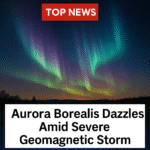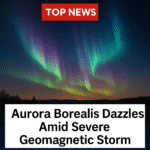


A rare and powerful G4-class geomagnetic storm lit up skies across the globe last night, giving millions of people a rare glimpse of the spectacular aurora borealis—far beyond its usual northern haunts.
Triggered by a massive coronal mass ejection (CME) from the Sun, the solar storm reached Earth’s atmosphere with such force that vivid auroras were seen as far south as Texas, Spain, and parts of India. The skies lit up in dazzling hues of green, pink, and purple, mesmerizing viewers and dominating social media feeds.
“This is the most vivid and widespread aurora event we’ve seen in over two decades,” said Dr. Lisa Monroe, a space weather scientist at NOAA. “The geomagnetic storm exceeded expectations and put on a truly unforgettable show.”
 What Caused It?
What Caused It?
The storm stemmed from an intense burst of solar plasma ejected from the Sun on May 30. As it slammed into Earth’s magnetic field on June 1, it created major magnetic disturbances, leading to enhanced auroral activity and potential disruptions in GPS systems, satellite communications, and power grids.
 Impact and Precautions
Impact and Precautions
 Some flights were rerouted due to high-frequency radio blackouts.
Some flights were rerouted due to high-frequency radio blackouts.
 Satellite operators reported temporary signal loss and reoriented spacecraft as a precaution.
Satellite operators reported temporary signal loss and reoriented spacecraft as a precaution.
 Power grid operators were placed on high alert, though major outages were largely avoided.
Power grid operators were placed on high alert, though major outages were largely avoided.
NOAA has issued alerts advising people and industries to monitor the storm’s ongoing activity, as aftershocks from solar flares could continue for the next 48 hours.
 A Global Spectacle
A Global Spectacle
From photographers in Alaska to stargazers in Germany, social media platforms were flooded with breathtaking images of the dancing lights above cities not usually graced by auroras. Even urban light pollution couldn’t fully dim the celestial display.
 Tips for Viewing (if it continues tonight):
Tips for Viewing (if it continues tonight):
 Find a dark location away from city lights.
Find a dark location away from city lights.
 Use aurora-tracking apps to monitor activity in real time.
Use aurora-tracking apps to monitor activity in real time.
 Bring a camera with manual settings for long exposures.
Bring a camera with manual settings for long exposures.
 Final Note
Final Note
Experts say we’re entering a peak period of solar activity, meaning more storms and auroras may occur in the coming months. “It’s an exciting—and potentially risky—time for both scientists and skywatchers,” said Dr. Monroe.
 #AuroraStorm #SolarFlare #SpaceWeather #NorthernLights
#AuroraStorm #SolarFlare #SpaceWeather #NorthernLights
<p>The post Aurora Borealis Shines Bright Across Globe Amid Major Geomagnetic Storm first appeared on toplivenews.com.</p>
The post Aurora Borealis Shines Bright Across Globe Amid Major Geomagnetic Storm appeared first on toplivenews.com.
<p>The post Aurora Borealis Shines Bright Across Globe Amid Major Geomagnetic Storm first appeared on toplivenews.com.</p>
The post Aurora Borealis Shines Bright Across Globe Amid Major Geomagnetic Storm appeared first on toplivenews.com.